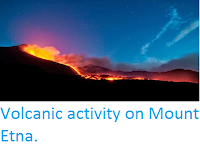The United States Geological Survey
recorded a Magnitude 5.7 Earthquake at a depth of 10 km, roughly 5 km to
the southwest of the town of Amatrice in Rieti Provice in Lazzio, Central
Italy, at about 10.25 pm local time (about 9.25 pm GMT) on Wednesday 18 January 2017. The event has been followed by several serious aftershocks, which are reported to have caused damage to a large number of buildings, and in addition has been linked to an avalanche that stuck a hotel near Pescara in the Abruzzo Region, an event which is known to have killed at least four people, with about twenty still missing.
Rescue workers searching the scene of an avalanche in the Abruzzu Region of Italy on 18 January 2017. Vigili del Fuoco.
Historically
Italy has suffered a number of devastating Earthquakes that lead to
large numbers of casualties, though in recent decades the country has
made serious attempts to prevent this, with better warning systems and
tighter building regulations, though the large number of historic
buildings in Italy, which cannot easily be replaced (and any attempt to
do so would be unlikely to succeed due to their high cultural value),
meaning that the country is unlikely to be completely risk free any time
soon.
Earthquake damage in a mountain village in central Italy following the 18 January 2017 event, AP.
Italy
is in an unusual tectonic setting, with the west of the country lying
on the Eurasian Plate, but the east of the country lying on the Adriatic
Plate, a microplate which broke away from North Africa some time in the
past and which is now wedged into the southern margin of Europe,
underlying eastern Italy, the Adriatic Sea and the west of the Balkan
Peninsula. This, combined with the northward movement of the African
Plate into Italy from the south, leads to uplift in the Apennine
Mountains that run the length of the country, and makes Italy extremely
prone to Earthquakes.
Map showing the tectonic plates underlying Italy and southern Europe, and the location of the l'Aquila Earthquake. Napoli Unplugged.
Witness
accounts of Earthquakes can help geologists to understand these events,
and the structures that cause them. The international non-profit
organisation Earthquake Report is interested in hearing from people who may have felt this event; if you felt this quake then you can report it to Earthquake Report here.
See also...









